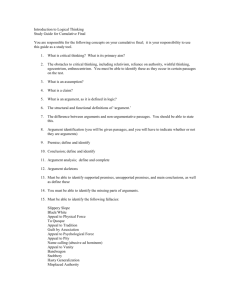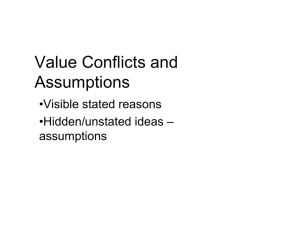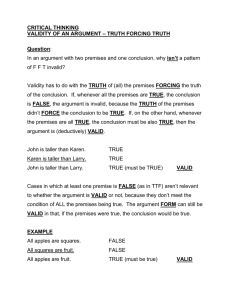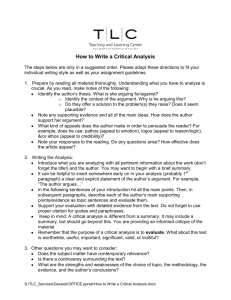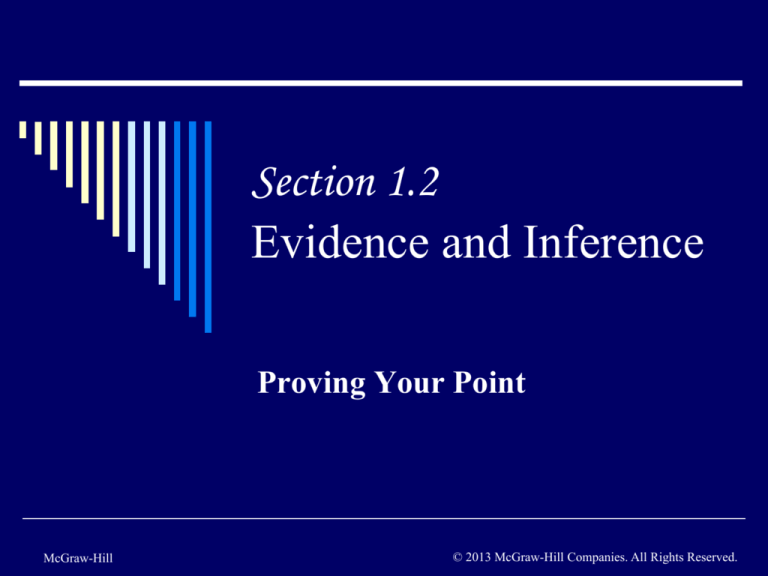
Section 1.2
Evidence and Inference
Proving Your Point
McGraw-Hill
© 2013 McGraw-Hill Companies. All Rights Reserved.
Logic
Logic attempts to determine how people
should reason if they want to avoid error
and falsehood.
1.2-2
Arguments
Argument—a group of statements that
attempt to establish a claim.
Conclusion—the claim that an argument
attempts to establish.
Premise—a reason for accepting the
conclusion of an argument.
1.2-3
Enthymemes
An enthymeme is an argument with an
unstated premise or conclusion.
For example: “Everybody does it, so I
should be allowed to do it, too.”
Missing premise: “If everybody does it, it is
permissible to do it.”
1.2-4
Principle of Charity
When interpreting an argument, choose
the interpretation that makes the most
sense from a logical point of view.
1.2-5
Steps in Identifying an
Argument
Identify the conclusion.
Identify the premises.
Spell out any unstated premises.
1.2-6
Conclusion Indicators
“thus,” “therefore,” “hence,” “so,” “then,”
“consequently,” “as a result,” “shows that,”
“means that,” “implies that,” “establishes that,”
“can concluded that,” etc.
For example: “Only things made of flesh and blood
can think. Therefore computers can’t think.”
Sometimes conclusions aren’t preceded by an
indicator word.
For example: “God exists, since the world needs a
designer.”
1.2-7
Premise Indicators
“since” “because,” “for,” “if,” “follows from,”
“given that,” “provided that,” “assuming that,”
etc.
For example: “She’s a vegetarian because she
things that eating meet is immoral.”
Sometimes premises are not preceded by
indicator words.
For example: “You have no control over the
neurons in your brain. It follows that you have no
control over anything you do.”
1.2-8
Deductive vs. Inductive
Arguments
In a valid deductive argument, the truth of
the premises guarantees the truth of the
conclusion
If the premises are true, the conclusion has
to be true.
In a strong inductive argument, the truth of
the premises only makes the conclusion
probable
If the premises are true, the conclusion may
still be false.
1.2-9
Deductive Arguments
A deductive argument is valid when the
conclusion logically follows from the
premises
In that case, it’s impossible for the premises
to be true and the conclusion false.
A deductive argument is sound when it’s
valid and all of its premises are true.
1.2-10
Affirming the Antecedent
(1) If p, then q. (2) p. (3) Therefore q.
For example:
(1) If the soul is immortal, then thinking
doesn’t depend on brain activity.
(2) The soul is immortal.
(3) Therefore, thinking doesn’t depend on
brain activity.
1.2-11
Denying the Consequent
(1) If p, then q. (2) Not q. (3) Therefore,
not p.
For example:
(1) If the soul is immortal, then thinking
doesn’t depend on brain activity.
(2) Thinking does depend on brain activity.
(3) Therefore, the soul is not immortal.
1.2-12
Hypothetical Syllogism
(1) If p, then q. (2) If q, then r. (3)
Therefore, if p, then r.
For example:
(1) If the Fed raises interest rates, it will be
more difficult to borrow money.
(2) If it’s more difficult to borrow money,
home sales will fall.
(3) Therefore, if the FED raises interest
rates, home sales will fall.
1.2-13
Disjunctive Syllogism
(1) Either p or q. (2) Not p. (3) Therefore
q.
For example:
(1) Either Sally walked or she rode the bus.
(2) She didn’t walk.
(3) Therefore, she rode the bus.
1.2-14
Affirming the Consequent
(Invalid)
(1) If p, then q. (2) q. (3) Therefore, p.
For example:
(1) If Chicago is the capital of Illinois, then
Chicago is in Illinois.
(2) Chicago is in Illinois.
(3) Therefore, Chicago is the capital of
Illinois.
1.2-15
Denying the Antecedent (Invalid)
(1) If p, then q. (2) Not p. (3) Therefore,
not q.
For example:
(1) If Joe is a bachelor, then Joe is a male.
(2) Joe is not a bachelor.
(3) Therefore, Joe is not a male.
1.2-16
Affirming a Disjunct (Invalid)
(1) Either p or q. (2) p. (3) Therefore, not
q.
For example:
(1) Either the car battery is dead or the car
is out of gas.
(2) The car battery is dead.
(3) Therefore, the car is not out of gas.
1.2-17
Inductive Arguments
A strong inductive argument is one that
would establish its conclusion with a high
degree of probability if its premises were
true.
A cogent inductive argument is a strong
one which contains only true premises.
1.2-18
Enumerative Induction
(1) X per cent of the observed members
of A are B. (2) Therefore, X percent of
the entire group of A are B.
For example:
(1) 54 per cent of the students in this
college are female.
(2) Therefore, probably, 54 per cent of all
college students are female.
1.2-19
Analogical Induction
(1) Object A has properties F, G, H, etc.
as well as the property Z. (2) Object B
has properties F, G, H, etc. (3)
Therefore, object B probably has
property Z.
For example:
(1) The Earth has air, water, and life.
(2) Mars has air and water.
(3) Therefore, Mars probably has life.
1.2-20
Hypothetical Induction
(Inference to the Best Explanation)
(1) Phenomena p. (2) If hypothesis H
were true, it would provide the best
explanation of p. (3) Therefore, it’s
probable that H is true.
For example:
(1) My car won’t start.
(2) The best explanation of that fact is that
the battery is dead.
(3) Therefore, it’s probable that the battery
is dead.
1.2-21
Criteria of adequacy for deciding
among competing hypotheses:
Consistency—internal and external.
Simplicity—number of assumptions
made by a hypothesis.
Scope—the amount of diverse
phenomena explained by a hypothesis.
Conservatism—fit with confirmed
hypotheses.
Fruitfulness—successful novel
predictions or problems solved.
1.2-22
Fallacious Arguments
Fallacious arguments fail to provide
good reasons for accepting a claim
because either:
The premises are dubious or
They do not support the conclusion.
1.2-23
An argument is fallacious if it
contains:
Unacceptable premises (premises as
dubious as they claim they’re trying to
support)
Irrelevant premises (premises that have
no bearing on the truth of the conclusion)
or
Insufficient premises (premises that do
not establish the conclusion beyond a
reasonable doubt).
1.2-24
Informal Fallacies
Unacceptable Premises: Begging the Question,
False Dilemma
Irrelevant Premises: Equivocation,
Composition, Division, Appeal to the Person,
Genetic Fallacy, Appeal to Unqualified
Authority, Appeal to the Masses, Appeal to
Tradition, Appeal to Ignorance, Appeal to Fear
Insufficient Premises: Hasty Generalization,
Faulty Analogy, False Cause
1.2-25
Begging the Question
An argument begs the question – or
argues in a circle – when its conclusion
is used as one of its premises.
For example: “Jane has telepathy,” says
Susan. “How do you know?” asks Jill.
“Because she can read my mind,” replies
Susan.
1.2-26
False Dilemma
An argument that presumes that only
two alternatives exist when in actuality
there are more than two.
For example: “Either science can explain
how she was cured or it was a miracle.
Science can’t explain how she was
cured. So it must be a miracle.”
1.2-27
Equivocation
Using the same word in two different
senses in a single argument.
For example: “(i) Only man is rational. (ii)
No woman is a man. (iii) Therefore no
woman is rational.”
1.2-28
Composition
Claiming that what is true of the parts is
true of the whole.
For example: “Subatomic particles are
lifeless. Therefore anything made out of
them is lifeless.”
1.2-29
Division
Claiming that what is true of a whole is
also true of its parts.
For example: “We are alive and we are
made out of subatomic particles. So they
must be alive too.”
1.2-30
Appeal to the Person
The attempt to refute an argument by
denigrating its presenter.
Also referred to as “ad hominem,” or “to the
man.”
For example: “You can’t believe Dr. Jones’s
claim that there is no evidence for life after
death. After all, he’s an atheist.”
1.2-31
Genetic Fallacy
Arguing that a claim is true or false on
the basis of its origin.
For example: “Jones’s idea is the result
of a mystical experience, so it must be
false (or true).”
Or: “Jane got that message from a Ouiji
board, so it must be false (or true).”
1.2-32
Appeal to Unqualified Authority
Citing a non-expert to make your point.
For example: “Psychiatry must be bogus
because Tom Cruise says it is.”
1.2-33
Appeal to the Masses
Arguing that something must be true (or
good) because everybody believes it (or
does it).”
For example: Said in 1800: “Slavery
must be a good thing because every
culture has had slaves.”
1.2-34
Appeal to Tradition
Arguing that something must be true (or
good) because it is part of an
established tradition.
For example: “Women should work at
home because that’s what they’ve
always done.”
1.2-35
Appeal to Ignorance
Using an opponent’s inability to
disprove a conclusion as proof of
the conclusion’s correctness, or
Using an opponent’s inability to
prove a conclusion as proof of its
incorrectness.
For example: “Bigfoot must exist
because no one has been able to
prove that he doesn’t.”
1.2-36
Appeal to Fear
Using the threat of harm to advance
one’s position.
For example: “If you do not convict this
criminal, one of you may be her next
victim.”
1.2-37
Hasty Generalization
Drawing a general conclusion about all
things of a certain type on the basis of
evidence concerning only a few things of
that type.
For example: “I know one of those psychics.
They’re all a bunch of phonies.”
1.2-38
Faulty Analogy
Arguing that things that resemble one
another in very limited respects
resemble one another in other respects.
For example: “Astronauts wear helmets
and fly in spaceships. The figure in this
Mayan carving seems to be wearing a
helmet and flying in a spaceship.
Therefore it is a carving of an ancient
astronaut.”
1.2-39
False Cause
Arguing that two events are causally
connected when they are not.
Latin scholars dubbed this the fallacy of
post hoc, ergo propter hoc, which means
“After this, therefore because of this.”
Example: “My cold got better after I wore
this crystal around my neck. So it must
have cured it.”
1.2-40

